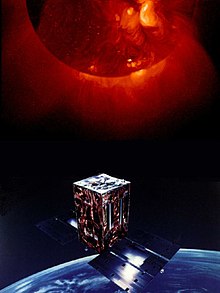Yohkoh

Artist concept of the Japanese Yohkoh spacecraft
|
|
| Names | Solar-A (before launch |
|---|---|
| Mission type | Heliophysics |
| Operator | ISAS / NASA / PPARC |
| COSPAR ID | 1991-062A |
| SATCAT no. | 21694 |
| Website | Yohkoh home page |
| Spacecraft properties | |
| Launch mass | 390 kilograms (860 lb) |
| Dimensions | 2 m (6 ft 7 in) x 2 m (6 ft 7 in) x 4 m (13 ft) |
| Start of mission | |
| Launch date | 02:30, August 30, 1991--> |
| Rocket | Mu-3S-II |
| Launch site | Kagoshima M1 |
| Orbital parameters | |
| Reference system | Geocentric |
| Perigee | 516 kilometres (321 mi) |
| Apogee | 754 kilometres (469 mi) |
| Inclination | 31.3° |
| Period | 97.4 min |
Yohkoh (ようこう, Sunbeam in Japanese), known before launch as Solar-A, was a Solar observatory spacecraft of the Institute of Space and Astronautical Science (Japan), in collaboration with space agencies in the United States and the United Kingdom. It was launched into Earth orbit on August 30, 1991 by the M-3S-5 rocket from Kagoshima Space Center. It took its first image on September 13, 1991 21:53:40.
The satellite was three-axis stabilized and in a near-circular orbit. It carried four instruments: a Soft X-ray Telescope (SXT), a Hard X-ray Telescope (HXT), a Bragg Crystal Spectrometer (BCS), and a Wide Band Spectrometer (WBS). About 50 MB were generated each day and this was stored on board by a 10.5 MB bubble memory recorder.
Because the SXT utilized a charge-coupled device (CCD) as its readout device, perhaps being the first X-ray astronomical telescope to do so, its "data cube" of images was both extensive and convenient, and it revealed much interesting detail about the behavior of the solar corona. Previous solar soft X-ray observations, such as those of Skylab, had been restricted to film as a readout device. Yohkoh therefore returned many novel scientific results, especially regarding solar flares and other forms of magnetic activity.
The mission ended after more than ten years of successful observation when it went into its "safehold" mode during an annular eclipse on December 14, 2001 20:58:33 and the spacecraft lost lock on the sun. Operational mistakes and other flaws combined in such a way that its solar panels could no longer charge the batteries, which drained irreversibly; several other solar eclipses had successfully been observed.
On September 12, 2005 the spacecraft burned up during reentry over South Asia. The time of reentry, as provided by the U.S. Space Surveillance Network, was 6:16 pm Japan Standard Time (JST).
...
Wikipedia
